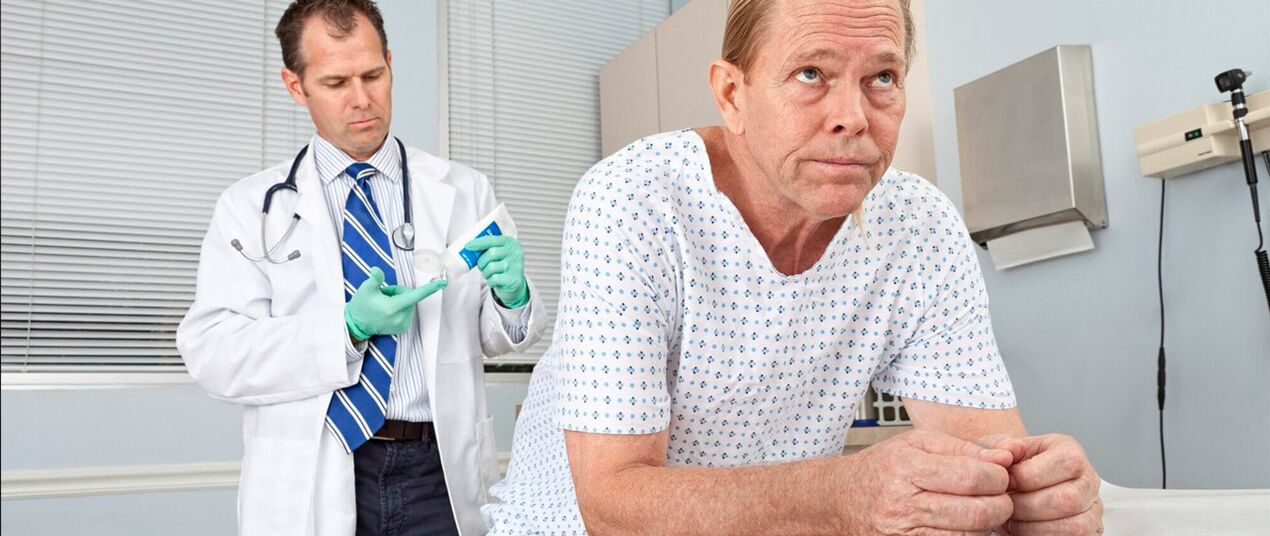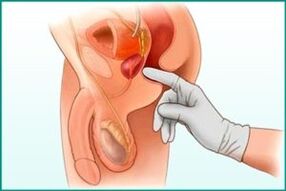
About half of male patients who visit urologist suffers from chronic prostatitis. The problems caused by a specific pathology worsen the quality of life, lead to depression and mental disorders.However, a clear understanding of the functions of the prostate gland and the development mechanism of inflammation allow us to correctly determine the symptoms and treat the disease in a timely manner.
The meaning of the term "prostatitis"
To this term, it is customary to understand the development of the inflammatory process in the fabrics of the prostate gland.Since it is present only in the male body, the disease is common in this category of the population.Its main function is the development of a specific fluid, which is involved in the following processes:
- forms and supports a certain environment in the urethra;
- Sperm diluted;
- guarantees the profitability of the sperm;
- Protects the parental parent system from infection.
Under the influence of a series of factors, the secretion of the secret slows down, which in itself becomes a violation.The cells of the prostate epithelium deserve periodically, but due to congestion they are not excreted, but accumulated, forming microlites - small pebbles.Covered by mucus, they clog the glandular ducts, leading to the formation of small abscesses.During this period, the body still continues to function normally, the external negative manifestations are absent.
The progression of the process (accumulation of dense formations, an increase in the concentration of purulent content) leads to an increase in the organ and the compression of the ureter, of the blood vessels and the nerve end.This is one of the causes of the disease.
Symptoms of the disease based on the patient complaints
Already on the stage described above, the first signs are manifested, which a man can only note.On the basis of these changes, it is possible to independently identify the development of inflammation at home.Of course, this diagnosis is indicative, but is considered a serious reason to contact a specialist.
Car -Diagnosis at home
What are the first signs of prostatitis in men?
Arranged outflow of urine.The compression of the urethral channel has increased in size from the fabrics of the prostate leads to its narrowing and, consequently, to prevent the outflow of urine.The patient must apply some effort during urination.
Output of an urine.Calls to empty the bladder are becoming more frequent.At the beginning, this happens at night, later during the day.Looking at him on a cup of more tea, the man continues to ignore the violations.
Pain in the lower abdomen.The symptom is a consequence of the accumulation of microlites.The sensations become unpleasant and are crushed, pull or burst into painful.In the evening or after physical effort, their increase can occur.
Violations of erection and ejaculation.The syndrome occurs against the background of stagnant phenomena and rarely appears.Driving this on fatigue and stress, the patient also ignores this sign.
Often the patient complains of a general deterioration of the condition, an increase in body temperature, which is also a sign of a development process.
The first signs of prostatitis in men require treatment, otherwise the process will go to a prolonged form.
Symptoms of acute inflammation
The illegal prostatitis lies in the fact that, without characteristic manifestations at the beginning, acute and rapid development begins, but then quickly chronic.

In order not to lose the moment and start treatment in time, a clear idea of the symptoms of the acute form is required.
- Fever, chills.
- An increase in body temperature at critical values (39 ° C).
- Serious pain in the region for perineum, lumbar and inguinal.
- Stage of urination: frequent and false impulses, a difficult outflow of urine or its temporary cessation.
- Pronounced intoxication: headache, weakness, pains of joints and muscles, tachycardia.
- Transparent or whitish exhaust from the urethra.
The examination of the rectal finger becomes impossible due to the formation of pain syndrome.Furthermore, it is contraindicated, since there may be a (diffusion) diffusion of infection with blood flow and the development of sepsis in the examination process.
Chronic relapse events
In a slow form, pathological processes of different types of disease may occur.However, based on the complaints of patients and diagnostic data, experts distinguish the following signs of prostatitis from chronic general order:
- Discomfort, moderate pains in the horse, which radiate to the sacred, to the lower back, scrotum, weakness and pain in the body.
- Gravity and rubber in the urinary channel during relationship or urination.The presence of purulent ascent exhaust from the urethra.
- I frequent urination, accompanied by an incomplete sense of emptying at the end of the process.
- The inability of fertilization associated with the lack of mobility of sperm, their agglutination or an increase in the acidity of the secret.
- Violation of ejaculation (premature or, on the contrary, prolonged), pain or feels deleted with orgasm.

Concomitant types of disease and signs
Urologists distinguish several phases of the chronic inflammation of the gland, each of which corresponds to certain events.
A characteristic feature for all species is a moderate pain syndrome in the pelvic floor.
| The form of prostatitis | Symptoms |
|---|---|
| Chronic bacterial | Dysuria, premature ejaculation |
| Pedal pain syndrome | Lack of other manifestations, except the pain |
| Inflammatory | Expressed problems with urination, discomfort in the genitals |
| Stagnant | In some cases, Dysuria, discomfort |
| Asymptomatic | There are no clinical events |
Professional diagnostics
The doctor can already determine the presence of prostate inflammation during a man's first visit.However, it is possible to determine etiology, stadium and complexity only with the help of instrumental and laboratory research.
Primary examination of the doctor
The history of the anamnesis is an investigation into the patient and the analysis of external symptoms is one of the important stages of the diagnosis.During the conversation, the doctor determines the presence of clinical signs and the cause of the development of the pathological process.Here, the patient's lifestyle, bad habits, the use of contraceptive methods and the presence of a sexual partner are important.At the same time, it attracts attention to the probability of existing diseases of close relatives and hereditary predisposition.
The next step is an examination of the rectal finger of the prostate gland. Palpation is performed to determine parameters such as:
Palpation is performed to determine parameters such as:
- the size of the organ;
- structure and contours;
- the presence of seals;
- Pain.
Laboratory test
The next step is to lead analysis.This category is quite extensive, therefore only a urologist determines the need for each of them.
Oam Khrateusterras the general conditions of the urinary system organs. The increase in the content of red blood cells, leukocytes and proteins, as well as the presence of mucus and other impurities, indicates a large course of the inflammatory process.
The urethral strip is a painful and unpleasant procedure, which, however, allows you to determine the presence of infection and establish its variety.
Urine bacteriological sowing allows you to identify the location of the lesion, a variety of infection and the type of pathogen.
The cytological analysis of the seed fluid is performed to determine its physical -chimic properties, mobility, activity and concentration of sperm, as well as the dog's level.Biomaterial fence is made directly in the laboratory after prostate massage.
The condition of the procedure is sexual abstinence during the day.In case of suspicion of chronic processing, this type of research is systematically carried out.
Symptoms detected using instrumental diagnostic methods
Hardware methods are recognized as the most effective, due to the reception of accurate and detailed information on the physical characteristics of the prostate gland and on the alleged pathological changes in its tissues.They significantly facilitated the work of doctors.
Of the entire variety of species, as a rule, only an ultrasound study is conducted and the rest of the methods is used if further results must be obtained.
The ultrasound is performed to view the gland and determine its general condition, size, consistency.The transrettal method is considered more informative - Truci.A special sensor is introduced into the rectum, which allows you to determine how the organ appears, identify tumors, adhesions, calculations, cystic formations and other pathological deviations.
Magnetic resonance imaging is prescribed to determine the type of prostatitis and more in terms of clarification of the results previously obtained, especially if some details have remained unclear.
Urofloometry determines the speed of the urine current, the time to reach its maximum value, the volume of the urine.It is performed using a special device.
Cystoscopy with a subtle probe allows to evaluate the conditions of the bladder and the urethral canal, as well as identifying the alleged and existing pathological changes.
The biopsy is carried out in case of suspicion of the oncological nature of the disease in order to exclude it.
The dangers of the asymptomatic course of the disease
Prostatitis, which has no symptoms, develops in patients of the more advanced age group.

The reasons for its aspect are:
- frequent hypothermia;
- constipation and hypodynamia;
- weakened immunity;
- decrease in sexual activity;
- The presence of chronic pathologies.
The provocative factors are:
- Age of a man;
- reduction of hormonal production;
- Weakening of prostate protective functions
- Degenerative processes in its tissues.
The lack of treatment due to the impossibility of a timely detection of the disease involves the occurrence of these consequences:
- Persistent erectile dysfunction;
- prostate tissue fibrosis;
- development of renal and hepatic insufficiency;
- urolithiasis;
- Benign hyperplasia of the prostate gland, adenoma, cancer.
Look for a doctor prematurely: complications
The danger of prostatitis lies in its rapid transition towards a chronic form with greased symptoms and the absence of an express clinical picture, as in an acute path.
This form may not occur for a long period of time, which leads to irreversible processes in the gland tissues and various types of complications:
- bladder, rear urethritis;
- prostate abscess;
- sclerosis of the tissue of the glands and obstruction of the erysful ducts;
- polycystic formations;
- calculating form development;
- impotence and infertility, problems with conception;
- Urinary system pathologies - cystitis, pieelonefrite, urolitiasis;
- Nervous-psychogenic-apathy disorders, prolonged depression, decrease in self-esteem.
Ways to relieve patient conditions
The characteristics of the choice of therapeutic tactics depend on the type of disease, the form of origin, the characteristics of the loss.
Symptomatic treatment
The acute manifestations of the disease are extremely painful for the patient.Therefore, the priority task is to eliminate them.For this, pharmacological treatment is used.With prostatitis, drugs are prescribed in men depending on the serious symptoms:
- Antibacterial drugs to eliminate pathogen.
- Diuretics are drugs to stabilize the work of the bladder to improve the outflow of urine.
- Analgesics: to eliminate pain in the head, joints and muscles.
- Antispasmodic and Alfa-1-surgery ships for smooth relaxing muscles.
An effective form of dosage is considered rectal supposed.The candles are used to relieve acute symptoms:
- With an antibiotic that eliminates painful cramps and fight contagious manifestations.
- With fans, leveling of inflammatory processes.
- Analgesic with analgesic, which improve blood microcirculation and restore the normal state of the prostate.
Elimination of the cause of inflammation
After stopping the acute symptoms, it is necessary to start the therapy of the main events.The treatment in this case aims to eliminate infection and restore blood circulation.The following groups of drugs are used for these purposes:
- antibiotics in tablets;
- anti -inflammatory drugs;
- immunomodulators;
- phytopiparrations.
If acute manifestations are absent, but signs of prostatitis in men are preserved, the patient continues to deal with physiotherapy, traditional medicine (pumpkin seeds, ginger and other drugs), alternative methods (treatment with leeches, bee bakers, manual therapy).A positive result is often obtained only after an adequate correction of power.
Primary prostatitis prevention and symptoms of exacerbation of a chronic form
Modern medicine successfully deals with the elimination of prostatitis, despite the long period of treatment.
For men who have transferred an acute form or barely recovered from the chronic current, it is important to comply with preventive measures:
- Change of life change:
- regular walks;
- active sports;
- Refusal of bad habits.
- Restoration of normal sexual behavior:
- the choice of a reliable partner;
- refusal of random ties;
- regular sexual relationships;
- Protected sexual intercourse.
- Compliance with a diet:
- refusal of fatty, fried and spicy foods;
- The use of healthy and natural products.
- Preventive exam by a doctor:
- Regular - once every six months - exams;
- pass a support therapy course;
- Execution of gymnastics exercises.
In modern living conditions, the inflammation of the prostate gland is not a sentence.Despite the severity and complexity of the current, a variety of clinical species, the disease can be perfectly treated.However, in order to avoid dangerous consequences and the development of serious complications, it is necessary to contact specialists in a timely manner.And for this you must know all the characteristics of the signs and symptoms of prostatitis.
























